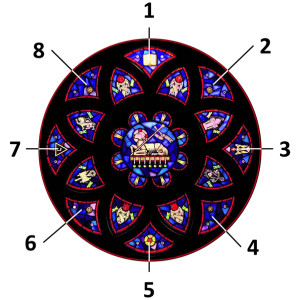In this section we are interested in the eight areas where the circles do not overlap one another. These are the semi-triangular shapes that look like the head of some sort of cutting instrument and reside at the extreme North, South, East and West of the Window.
The symbols break out as follows:
1. Book. The Word of God
2. 4. 6. 8. Dark sky with three stars.
3. Dove. The Holy Spirit
5. Simplified version of Martin Luther’s mandala (seal).
7. Flaming equilateral triangle with a mysterious symbol in the center.
The even numbered areas are mainly decorative reminding us that the entire mandala is set against a dark sky. Each area has a five pointed star and two smaller six pointed stars. My guess is that the five pointed star is intended to represent the star of Bethlehem and the six pointed star is the Star of David. In this way, the design balances both the Old Testament and New Testament traditions similar to what was done with the prophets and the evangelists in the previous section.
The remaining pairings are interesting. The book on top is a symbol for the Word of God which is paired with Martin Luther’s mandala at the bottom. So reading the mandala vertically from top to bottom we have the Word of God followed by Jesus, who literally put human breath into the Word of God, and finally Luther who helped make the Word of God available to many by translating the Bible from Latin into the common tongue.
The second pairing is a dove on the right and an equilateral triangle on the left.
The dove is the symbol for the Holy Spirit. The circle around its head denotes divinity. The red color of the circle suggests Pentecost. Normally the dove would be pointed down to indicate it is descending from heaven. Here, the dove is rotated 90 degrees clockwise from the descending position and points towards the center. This is important to note for our next discussion.
The equilateral triangle area is interesting. I will assume a Christian context for this discussion. We have three symbols: An equilateral triangle, three flames, and something in the center of the triangle which looks like a 7 that has fallen on its side. Recalling that the dove was rotated 90 degrees clockwise. We assume a similar rotation for the three symbols, i.e., mentally rotate them 90 degrees counterclockwise to see their normal orientation. This gives the Hebrew letter yod in the center of the triangle.
Yod is shorthand for Yahweh, the sacred Hebrew name of God. The equilateral triangle is a common symbol for the trinity. Putting the yod inside of an equilateral triangle is reminding us that our Old Testament Yahweh was indeed a Triune God. The combination of these two symbols is not common, but does occur. The three flames add further emphasis. The number three again suggests the Trinity. The flames remind us of the Holy Spirit on the day of Pentecost. They also remind us of the fire-like manifestations of God’s presence in the Old Testament. The pillar of fire, the descent onto Mount Sinai, and especially the burning bush where God tells Moses ‘I Am That I Am’.
If we read the PLU mandala across the center from left to right we encounter a God who is Father, God the Son, and God the Holy Spirit in both the Old and New Testaments. This again emphasizes the full breadth of Scripture, a common theme throughout the window. Well done.
Professor Jesse Pflueger must have been a man of great intellect and knowledge. I would have loved to have taken a class from him.
After a short break we will move to a new mandala in Part 5.

